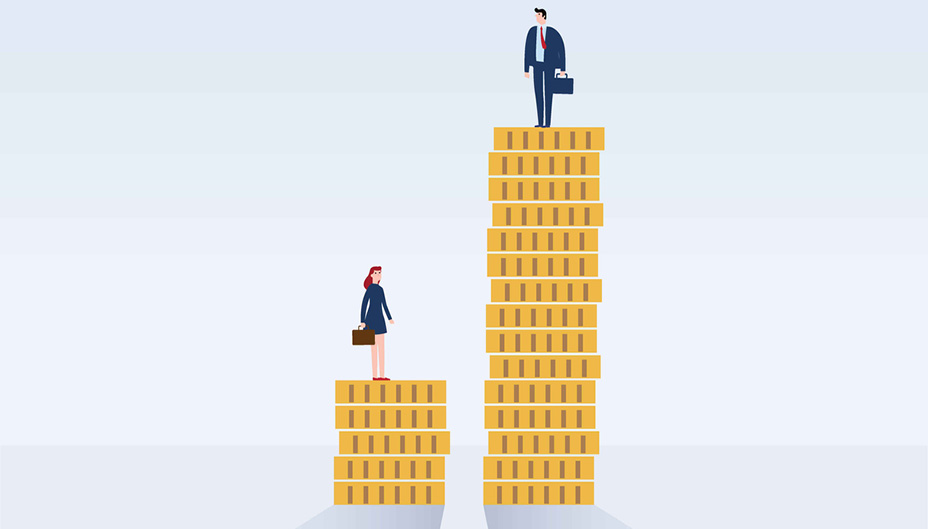Canada's Gender Wage Gap is Shrinking
Written by Rita Silvan
Published on November 8, 2019
minute read
Share:
With the release of the latest data on the pay gap between men and women in Canada, there's good news and not-so-good news.
On the upside, the gender wage gap is shrinking. In 20 years, from 1998 to 2018, the gender gap in hourly wages has declined by 5.5 percentage points — from 18.8 per cent to 13.3 per cent.
On the downside, there's still a gap.
According to the data, women between the core working ages of 25 to 54 earned $26.92 per hour in 2018, while men in the same group earned $31.05 — a $4.13 hourly difference. Put another way, women earned just 87 cents for every dollar men did in 2018.
"Given that women in Canada have surpassed men in educational attainment, diversified their fields of study at post-secondary institutions, and increased their representation in higher-status occupations, the persistence of gender-based wage inequality warrants continued attention," the researchers said.
The research report, released by Statistics Canada on Oct. 7, identifies a number of factors related to both the narrowing of the gap and the continued existence of the gap. Overall, the report attributed the narrowed gap largely to changes in the distribution of men and women across occupations, higher educational achievements by women and a reduced number of men in unionized jobs. On the flip side, researchers said the gap still exists largely because of the distribution of women and men across industries and a higher portion of women holding part-time work.
Let's take a closer look at a few of the factors.
Higher Education
According to the latest data, women overall are now more educated than men — a factor that contributed to the smaller gap. Compared with 20 years ago, more women now hold at least a bachelor's degree versus their male counterparts. Since workers with higher education earn more on average, Statistics Canada said the increase in educational attainment by women accounted for 12.7 per cent of the decline in the gender pay gap since 1998.
Career Choice
Despite the gains made in education, the statistics show that career and industry choice are big factors working against women when it comes to higher wages. Some occupations have boosted women's average earnings, such as those in law, social, community and government services, education, business and financial services. However, women lost ground in other occupations, including natural and applied sciences, administration and financial supervision. Here, men not only outnumbered women, but also saw faster wage growth. Women also lost out in high-paying sectors such as construction, manufacturing, mining, quarrying and oil and gas extraction, all of which tend to be male-dominated.
The Hours
According to the data, women are more likely to work on a part-time basis compared to men, an ongoing contributing factor to the gap. While that data shows fewer women worked part-time in 2018 (16 per cent) than 1998 (21 per cent), more than three-quarters of part-time workers are still women.
Union Coverage
Researchers said part of the reason for the narrowing of the gap is because men's earnings are coming under pressure. The number of men employed in union jobs decreased, especially in manufacturing which saw a slump during this reporting period, while the proportion for women — typically in healthcare, social assistance, and education — was stable.
The researchers noted that since union coverage usually means higher average wages, the decrease in the proportion of men with union coverage was a factor in the shrinking gender wage gap.
Did you know...
According to the World Economic Forum's 2018 Global Gender Gap Report, the most challenging gender gaps to close are those related to economics and political empowerment. On the economic front, the World Economic Forum projects it will take 202 years to close the economic gap between men and women globally.
RBC Direct Investing Inc. and Royal Bank of Canada are separate corporate entities which are affiliated. RBC Direct Investing Inc. is a wholly owned subsidiary of Royal Bank of Canada and is a Member of the Canadian Investment Regulatory Organization and the Canadian Investor Protection Fund. Royal Bank of Canada and certain of its issuers are related to RBC Direct Investing Inc. RBC Direct Investing Inc. does not provide investment advice or recommendations regarding the purchase or sale of any securities. Investors are responsible for their own investment decisions. RBC Direct Investing is a business name used by RBC Direct Investing Inc. ® / ™ Trademark(s) of Royal Bank of Canada. RBC and Royal Bank are registered trademarks of Royal Bank of Canada. Used under licence.
© Royal Bank of Canada 2025.
Any information, opinions or views provided in this document, including hyperlinks to the RBC Direct Investing Inc. website or the websites of its affiliates or third parties, are for your general information only, and are not intended to provide legal, investment, financial, accounting, tax or other professional advice. While information presented is believed to be factual and current, its accuracy is not guaranteed and it should not be regarded as a complete analysis of the subjects discussed. All expressions of opinion reflect the judgment of the author(s) as of the date of publication and are subject to change. No endorsement of any third parties or their advice, opinions, information, products or services is expressly given or implied by RBC Direct Investing Inc. or its affiliates. You should consult with your advisor before taking any action based upon the information contained in this document.
Furthermore, the products, services and securities referred to in this publication are only available in Canada and other jurisdictions where they may be legally offered for sale. Information available on the RBC Direct Investing website is intended for access by residents of Canada only, and should not be accessed from any jurisdiction outside Canada.
Explore More

Here’s What Every Canadian Should Know About Estate Planning
Insights from Leanne Kaufman to help you feel more confident as you plan
minute read

3 Things We're Watching This Week
What the Inspired Investor team is watching
minute read

What’s Driving the Recent Surge in Gold Prices
Here are some things to watch with the gold market
minute read
Inspired Investor brings you personal stories, timely information and expert insights to empower your investment decisions. Visit About Us to find out more.







